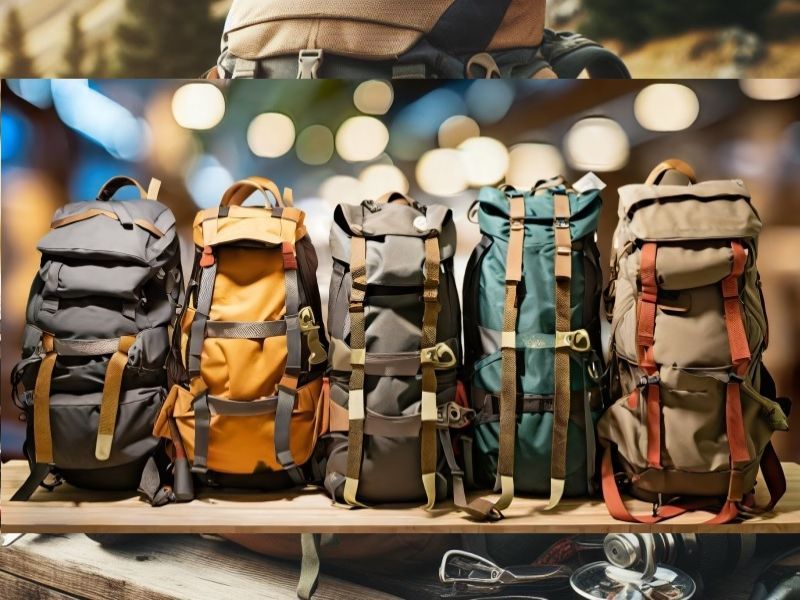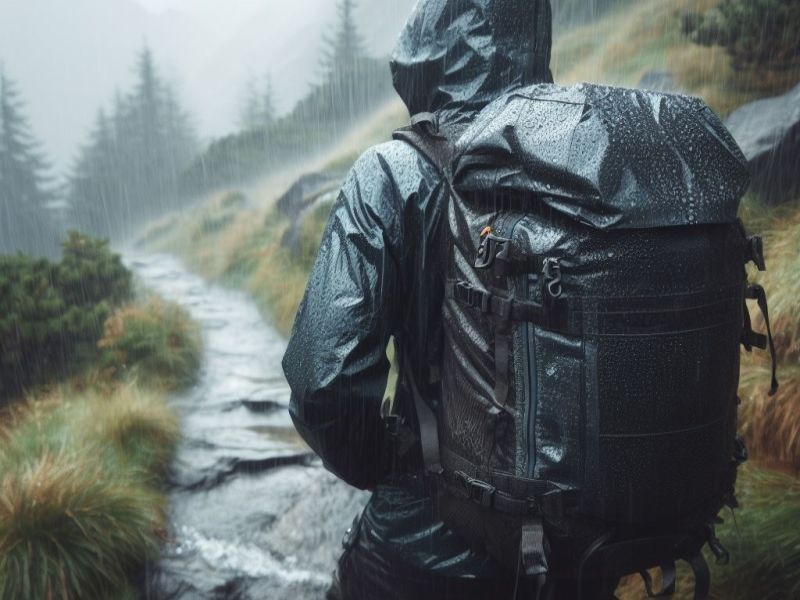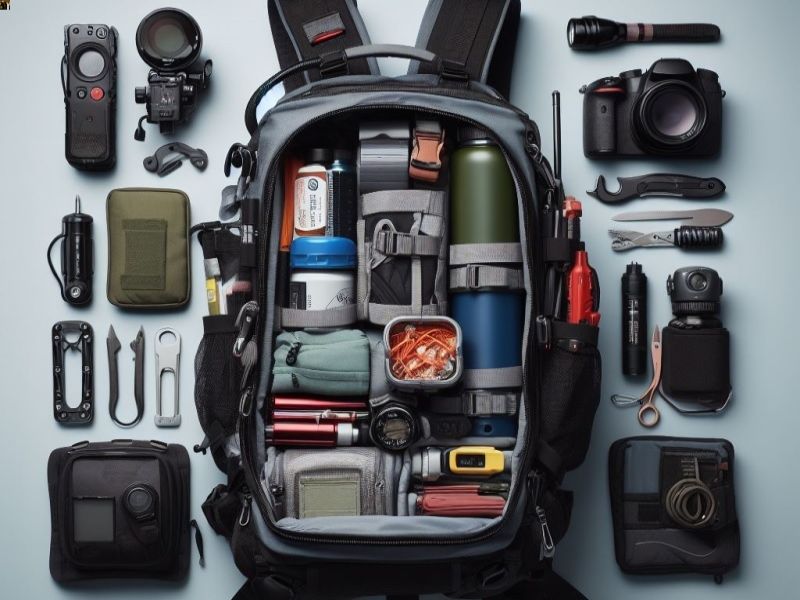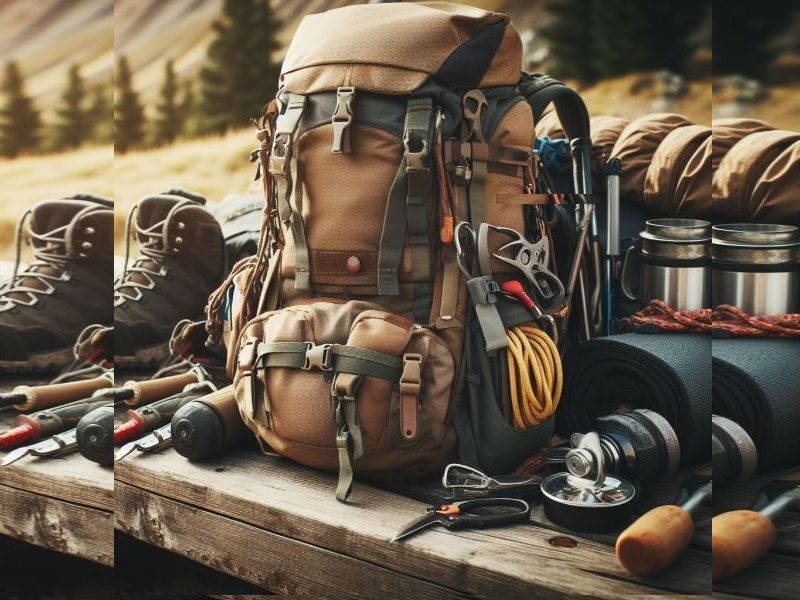How to Select the Perfect Backpack for Your Outdoor Adventures
Are you gearing up for your next backpacking or hiking adventure? Choosing the best backpack is a pivotal decision to make or break your outdoor experience. In this comprehensive guide, we’ll walk you through the essential factors to consider when selecting the ideal backpack. From capacity to material selection, comfort, and specialized gear needs, we’ve got you covered. Whether you’re a seasoned hiker or a newbie to the trails, this article will help you make an informed decision. Join us as we delve into the world of backpacks and discover how to embark on your adventures fully prepared.
Related Article: Backpacking Checklist for 2024
Finding the Best Backpack Capacity for Your Backpacking and Hiking Trip Duration

When planning your next backpacking or hiking adventure, one of the most critical decisions you’ll make is choosing the best backpack capacity. The size of your backpack can significantly impact your comfort and overall experience on the trail.
How to Select the Ideal Backpack Capacity Based on Trip Duration
Your choice of backpack capacity plays a pivotal role in ensuring you have the best backpacking experience. Short-day hikes typically require smaller packs, ensuring you can easily carry your essentials, such as water, snacks, and a lightweight jacket.
Tailor your backpack capacity to the duration and nature of your trips. For example, consider a 20-30-liter backpack for day hikes, while overnight trips benefit from 40-50-liter packs, providing ample space for clothing, sleeping gear, and food.
When embarking on multi-day treks or backpacking expeditions, opt for backpacks with capacities exceeding 60 liters. These spacious packs are designed to accommodate everything you’ll need, including extra clothing, camping gear, and a sufficient food supply.
Matching Backpack Capacity to Trip Duration for Optimal Comfort and Preparedness
One of the keys to a successful backpacking adventure is matching your backpack’s capacity with the trip’s duration and the gear you’ll be carrying. This ensures that you’re neither overburdened nor underprepared.
Day hikes shine with 20-30-liter backpacks, striking a perfect balance between lightweight and functional, ideal for carrying the essentials.
Overnight trips typically find comfort in 40-50-liter backpacks, providing sufficient space for a change of clothes, sleeping gear, and nourishment.
For extensive multi-day hikes, consider backpacks with capacities exceeding 60 liters, offering the spaciousness required for extra clothing, camping equipment, and an extended food supply.
How a Properly Fitted Backpack Reduces Strain and Maximizes Comfort
Selecting a backpack with the best capacity is not only about carrying what you need; it’s also about preserving your comfort and physical well-being.
A well-fitted backpack plays a pivotal role in distributing the load evenly, thereby reducing the strain on your shoulders and back.
These backpacks allow you to carry your essentials while maintaining balance, promoting comfort during your outdoor escapades.
By integrating these essential tips and aligning your backpack capacity with the demands of your adventures, you’re well on your way to enjoying the best backpacking and hiking experiences.
Selecting Durable and Weather-Resistant Backpack Materials

Choosing the right materials for your backpack is a critical decision that directly affects its durability and performance on the trail.
Key Backpack Materials to Consider for Strength and Weather Resistance
When selecting the best backpack for backpacking and hiking, consider various materials.
Common options include nylon, polyester, and Cordura fabric.
Nylon is known for its lightweight and water-resistant properties, making it an excellent choice for all-weather hiking.
Polyester is durable and abrasion-resistant, ideal for rough terrains and extended use.
Cordura fabric excels in heavy-duty applications, providing outstanding strength and resistance to tears and abrasions.
Achieving the Optimal Balance of Weight, Durability, and Weather Protection
The choice of material also affects the weight of your backpack. Lightweight materials are preferred for ultralight backpacking, while heavier materials offer enhanced durability.
Assess the balance between durability, weight, and weather resistance. This depends on the specific demands of your hikes and the environmental conditions you’ll encounter.
For rainy or wet climates, prioritize materials with water-resistant coatings or integrated rain covers.
How Backpack Material Selection Impacts Overall Durability and Lifespan
The material of your backpack significantly contributes to its lifespan. Durable materials can withstand wear and tear, ensuring your backpack lasts through multiple adventures.
Regular maintenance, such as cleaning and waterproofing, can extend the life of your backpack, regardless of the material used.
Understanding how to care for your backpack based on its material is essential for long-term use.
By selecting the right materials for your backpack, you’re setting the foundation for a durable and reliable companion on your backpacking and hiking journeys.
Achieving Comfort Through Proper Backpack Fit and Adjustments

Ensuring that your backpack fits comfortably on your back is paramount for an enjoyable and pain-free hiking or backpacking experience.
Finding the Right Backpack Fit Based on Your Body Type
Your backpack should match your body type. Different brands and models offer various fits, so it’s essential to find one that suits your body shape.
Pay close attention to features like adjustable shoulder straps, hip belts, and load lifters, which allow you to fine-tune the fit.
A properly fitted backpack prevents discomfort and minimizes the risk of injury during your journeys.
Customizing Your Backpack Fit Through Strap and Belt Adjustments
Once you’ve selected the right backpack, it’s crucial to adjust it correctly. Start by tightening or loosening the shoulder straps to ensure the weight is evenly distributed.
The hip belt should sit snugly on your hips, transferring the load from your shoulders to your hips, and reducing fatigue.
Load lifters, when properly adjusted, keep the backpack close to your body, enhancing balance and stability.
How a Well-Fitted Backpack Enhances Comfort on Long Hikes
A well-fitted backpack significantly reduces the strain on your body during extended hikes. The weight is distributed optimally, decreasing the pressure on your back, shoulders, and hips.
This comfort translates into longer and more enjoyable hikes, allowing you to explore nature without discomfort.
Regularly check and adjust your backpack’s fit, especially on multi-day trips, to ensure sustained comfort.
Choosing a backpack that fits your body type and adjusting it for optimal comfort is a crucial aspect of a successful backpacking or hiking experience.
Optimizing Backpack Organization and Accessibility of Gear

Efficient organization and quick accessibility of your gear are essential factors when choosing the best backpack for backpacking and hiking.
Key Features for Strategic Backpack Organization and Accessibility
Evaluate the backpack’s design for pockets and compartments. Look for multiple compartments to organize your gear efficiently.
Consider features like hydration reservoir sleeves, zippered pockets, and mesh compartments to accommodate various items.
Well-organized backpacks make it easier to access specific gear without emptying your entire bag.
How an Organized Backpack Enhances Convenience on the Trail
An organized backpack minimizes the time spent searching for gear, allowing you to focus on your hike.
Quick access pockets for essentials like water, maps, and snacks ensure you’re always prepared for what the trail throws your way.
An efficiently organized backpack can help maintain your momentum and energy during your outdoor adventures.
Accessorizing Your Backpack with Quick Access Pockets
Many backpacks come with dedicated pockets for water bottles, maps, and snacks. These quick-access features are invaluable on the trail.
Easily accessible pockets ensure you stay hydrated, navigate your route, and refuel without disrupting your hike.
Choose a backpack that provides easy access to the gear you use frequently to keep your experience hassle-free.
Efficient organization and quick access to your essentials can make a significant difference in your overall hiking and backpacking experience.
Achieving Proper Weight Distribution and Utilizing Ergonomic Features
Proper weight distribution and ergonomic features in your backpack are key to a comfortable and enjoyable hiking and backpacking journey.
Balancing and Distributing Weight Evenly Within Your Pack
Evenly distributing the weight within your backpack is essential for maintaining balance and reducing strain on your back and shoulders.
Use the compartments and pockets strategically, placing heavy items closer to your back and lighter items towards the outside.
Regularly check and adjust the load to prevent discomfort and fatigue during your hike.
Ergonomic Backpack Features for Enhanced Support and Reduced Strain
Look for ergonomic features such as padded shoulder straps, a padded hip belt, and a contoured back panel.
These features provide extra comfort and support, making your backpacking experience more enjoyable.
Ergonomic design also minimizes pressure points, allowing you to hike longer and further.
Utilizing Innovations in Backpack Technology for Improved Performance
Stay updated with the latest backpack innovations, such as adjustable suspension systems and load-stabilizing features.
These advancements can significantly improve the comfort and performance of your backpack.
By embracing new technology, you can optimize your hiking and backpacking experiences.
Balancing the load and considering ergonomic design elements in your backpack are pivotal for minimizing physical strain and maximizing comfort during your outdoor adventures.
Choosing a Waterproof Backpack for Protection from the Elements
When choosing a backpack for backpacking and hiking, it’s crucial to consider how well it can protect your gear from the elements.
Selecting a Waterproof Backpack for Reliable Weather Protection
Look for backpacks designed with weatherproofing features like water-resistant materials and zippers.
These features ensure your gear stays dry in unexpected rain or wet conditions.
Weatherproofing is especially important when you hike in variable or rainy climates.
Safeguarding Your Gear from Rain, Snow and Other Environmental Factors
Ensure your backpack can protect your gear not only from rain but also from snow, dust, and other environmental factors.
Consider using a rain cover or waterproofing spray for added protection, especially for longer hikes.
Keeping your gear dry is essential for a comfortable and safe outdoor experience.
Maintaining Water Resistance Through Proper Backpack Care
Over time, the water-resistant properties of your backpack may diminish.
Regularly clean and maintain your backpack to retain its water resistance. Follow the manufacturer’s care instructions.
Proper maintenance ensures your backpack continues to protect your gear during your outdoor journeys.
Selecting a backpack with excellent water resistance and taking care of it over time is essential to safeguard your gear against the unpredictable elements of the great outdoors.
Striking the Right Balance Between Features and Weight
When choosing a backpack for backpacking and hiking, you’ll need to strike a balance between the features you desire and the weight you’re willing to carry.
Weighing the Benefits of Features Against Their Added Weight
Different backpacks come with varying features. Consider your priorities, such as extra pockets, attachment points, and special compartments.
Understand that additional features often mean added weight. Balance the benefits of these features with the extra load.
For ultralight backpacking, opt for minimalist designs that prioritize weight reduction.
Ultralight Backpacks for Minimalist Hikers Prioritizing Weight Savings
Ultralight backpacks are designed for hikers who prioritize weight savings above all else.
These backpacks often use advanced materials and minimalistic designs to cut down on weight.
Consider the trade-offs in terms of comfort and features when choosing an ultralight backpack.
Evaluating the Trade-Offs Between Extra Features and Minimalist Design
Your choice of backpack should align with your hiking style and personal preferences.
Be aware of the trade-offs; choosing a minimalist design may mean sacrificing some comfort and convenience.
It’s crucial to strike the right balance between features and weight, ensuring a backpack that complements your hiking goals.
Selecting a backpack that aligns with your hiking style and the balance between features and weight is key to enjoying your outdoor adventures.
Selecting the Right Backpack Frame Type for Your Needs
The type of frame in your backpack significantly impacts its performance and comfort during hiking and backpacking trips.
Key Differences Between Internal, External, and Frameless Backpack Designs
Internal frame backpacks offer excellent weight distribution and stability. They are ideal for most hiking and backpacking trips.
External frame backpacks are known for their load-bearing capacity and ventilation. They suit heavy loads and extended journeys.
Frameless backpacks are ultralight and best for minimalist hikers who prioritize weight savings over additional features.
The Benefits and Drawbacks of Each Frame Type
Internal frame backpacks are versatile and comfortable. They conform to your body, providing excellent balance and support.
External frame backpacks excel at carrying heavy loads, but their design may be less suitable for narrow, overgrown trails.
Frameless backpacks are the lightest option but may lack the comfort and features of framed alternatives.
The Impact of Frame Type on Load Distribution and Stability
The frame type you choose influences how the load is distributed across your body.
Internal frame backpacks ensure even weight distribution and better balance.
External frame backpacks excel at carrying heavy loads, but they can be less stable on uneven terrain.
Understanding the different backpack frame types and their suitability for your hiking style is essential in choosing the best backpack for your outdoor adventures.
Choosing a Backpack for Your Specialized Gear and Activity Needs

If you have specific gear or equipment requirements for your hiking and backpacking adventures, it’s essential to choose a backpack that accommodates these needs.
Selecting a Backpack Tailored to Your Chosen Outdoor Activities
Consider your unique outdoor pursuits, such as photography, climbing, or backcountry skiing.
Different activities may require specialized backpacks with features like camera compartments or attachment points for climbing gear.
Choose a backpack that aligns with your specialized gear and adventure goals.
Organization Through Specialized Pockets and Attachment Points
Look for backpacks with specialized pockets and attachment points designed for your chosen activity.
These features can help you organize and access your gear more efficiently during your adventures.
Ensure that your backpack can securely hold and protect your specialized equipment.
Customizing Your Pack for Unique Gear Requirements
Some backpacks offer customization options, allowing you to adjust the layout and compartments to suit your specific requirements.
This adaptability can be invaluable when you have varied gear needs for different trips.
Explore backpacks with modular features that let you tailor the pack to your unique hiking goals.
By selecting a backpack that caters to your specialized gear and outdoor activities, you can enhance your experience and ensure that your equipment is readily accessible and well-protected.
Researching Brands and Budget Considerations for Your Backpack
Evaluating reputable brands and considering your budget are crucial steps when selecting the best backpack for backpacking and hiking.
Researching Top Backpack Brands Known for Quality
Research reputable backpack brands are known for their quality and durability. Brands like Osprey, Kelty, and TETON Sports are popular choices.
Explore the range of offerings from these brands, as they often have a variety of models designed for different hiking styles.
Read reviews and seek recommendations to get insights into the performance and reliability of specific models.
Finding a High-Quality Backpack Aligned with Your Budget
Determine your budget for a backpack and aim to find a balance between quality and affordability.
Keep in mind that a high-quality backpack is an investment in your outdoor adventures, and it’s worth allocating a reasonable budget.
Consider sales, discounts, or previous season’s models to find quality backpacks at more affordable prices.
Using Reviews to Choose the Best Backpack for Your Needs and Budget
Take advantage of online reviews and recommendations to identify backpacks that offer excellent value for your budget.
Online communities, forums, and expert reviews can provide valuable insights into backpack performance and user satisfaction.
Make an informed decision that aligns with your budget and meets your backpacking needs.
By researching reputable brands and aligning your budget with quality backpack options, you can secure a reliable and high-performing backpack that enhances your outdoor experiences.
Conclusion: How to Choose the Perfect Backpack for Hiking and Backpacking
In the world of backpacking and hiking, the right backpack can be your most trusted companion. From selecting the perfect capacity to considering material durability, comfort, and gear requirements, every decision matters. By following the guidance in this article, you’re well-equipped to choose the best backpack for your unique outdoor pursuits. Your comfort, convenience, and safety are paramount on the trail, and the backpack you select plays a significant role in ensuring an enjoyable and memorable experience. As you prepare for your next journey, may your chosen backpack be as reliable and adventurous as the great outdoors itself.
Frequently Asked Questions About Selecting the Best Hiking and Backpacking Backpack
FAQ 1: What is the ideal backpack capacity for day hiking?
A capacity of 20-30 liters is generally ideal for day hikes. It offers sufficient space for essentials like water, snacks, a light jacket, and basic gear.
FAQ 2: Can I use a daypack for overnight hiking trips?
For overnight hikes, consider a backpack with a 40-50 liter capacity. It provides room for a change of clothes, sleeping gear, and food.
FAQ 3: What’s the difference between internal and external frame backpacks?
Internal frame backpacks offer better weight distribution and comfort. External frame backpacks excel at carrying heavy loads and providing ventilation.
FAQ 4: How can I waterproof my backpack for rainy hikes?
To waterproof your backpack, consider using a rain cover or waterproofing spray. Ensure that zippers and seams are also treated.
FAQ 5: Are ultralight backpacks comfortable for long hikes?
Ultralight backpacks prioritize weight savings, which may involve sacrificing some features and comfort. They are best suited for minimalist hikers
FAQ 6: Can I customize a backpack for specialized activities?
Some backpacks offer customization options, allowing you to adjust compartments and features to suit your unique hiking needs.
FAQ 7: How do I balance quality and budget when buying a backpack?
To find the right balance, research reputable backpack brands and seek sales or discounts. Consider the purchase an investment in your outdoor adventures.
FAQ 8: What are the best brands for hiking backpacks?
Reputable brands for hiking backpacks include Osprey, Gregory, Deuter, and many others known for their quality and durability.
FAQ 9: How often should I clean and maintain my backpack?
Regular maintenance is key to preserving your backpack’s performance. Clean it after trips, and follow the manufacturer’s care instructions.
FAQ 10: What’s the best way to adjust a backpack for comfort?
Adjust your backpack’s straps, hip belt, and load lifters for optimal comfort. Make sure the weight is evenly distributed, and the pack fits your body type.









